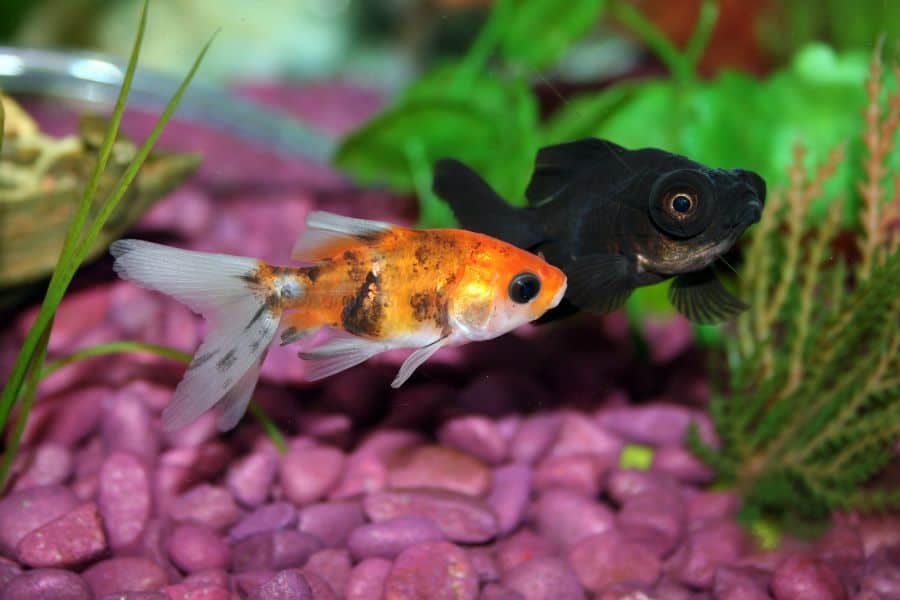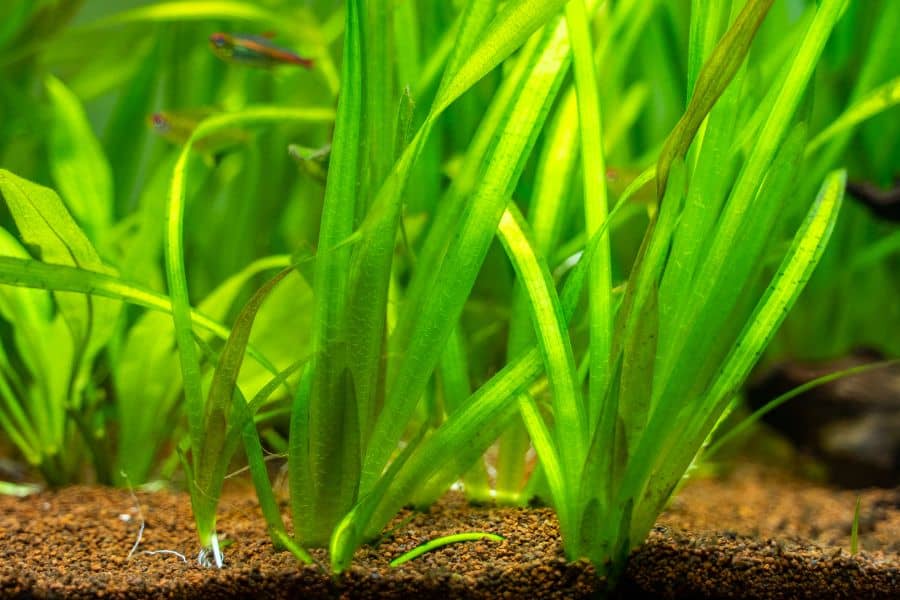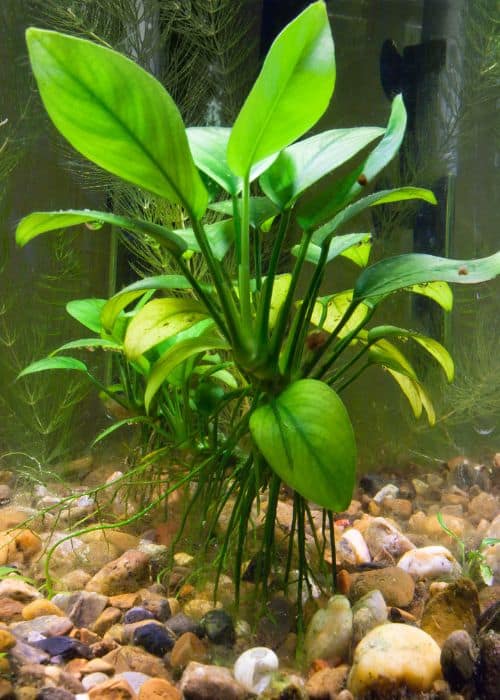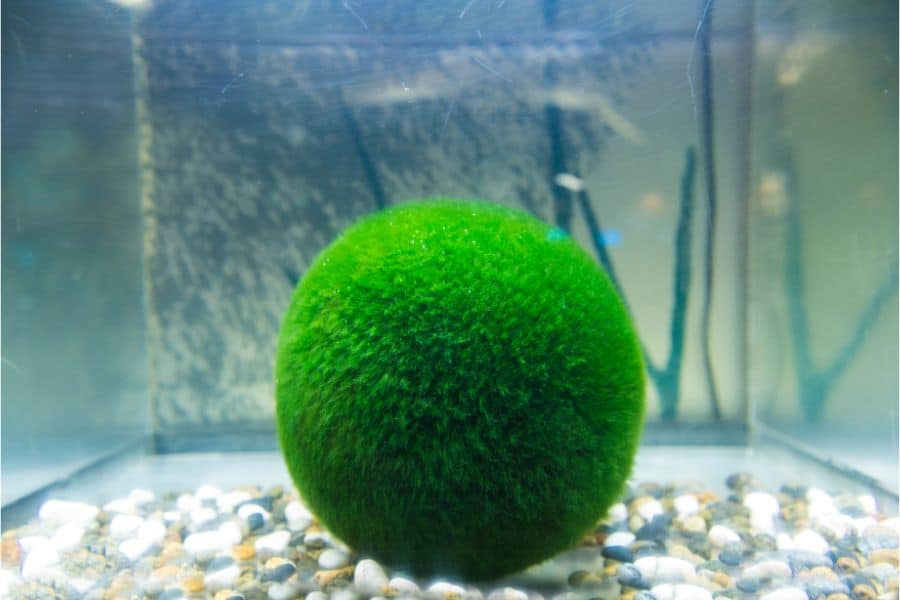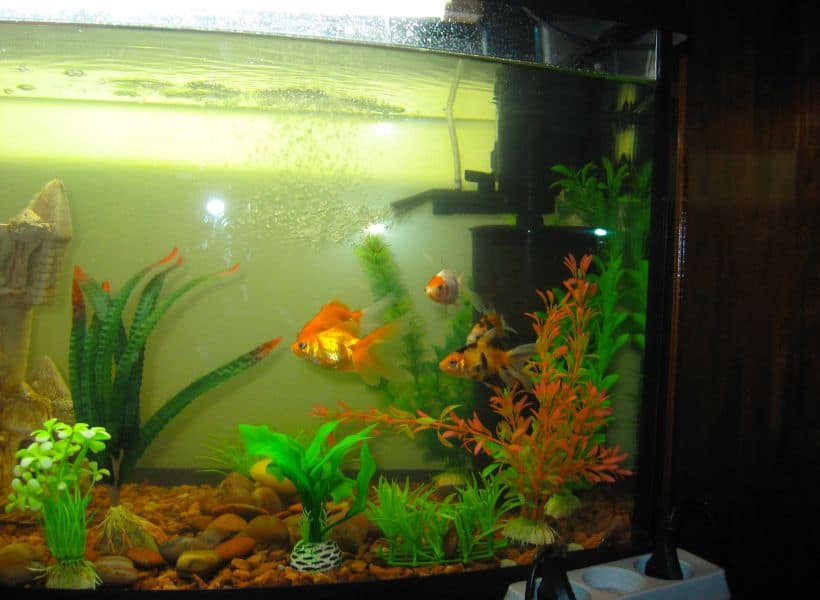Can goldfish live in planted tanks? Yes, of course! However, it is more challenging to maintain a planted aquarium than a bare-bottom tank with lifeless plants.
Goldfish can be quite active and destructive due to their constant search for food. This causes goldfish owners a difficult time creating stable, aesthetically pleasing aquascapes.
Therefore, careful selection and placement of plants is essential.
A planted goldfish tank requires permanent work but this is a tradeoff for the joys of keeping these entertaining and big-personality fish.
Benefits of a Planted Goldfish Tank
Goldfish benefit from live plants in their tanks. These fish, albeit with their destructive habits, are equally deserving of a nicely planted set-up as others.
Goldfish enjoy playing around with plants, swimming through them, hiding in them, and snacking on them. It makes a more natural habitat for them and encourages natural behaviors. Goldfish are intelligent, busy, ‘doing’ fish; they really benefit from a stimulating environment with plenty of things to do.
Live plants oxygenate tank water and break down organic wastes. This natural filtration helps the water stay clear and cleaner for longer.
Furthermore, thriving plants will make your tank resemble a real outdoor environment. This is probably the most common reason goldfish keepers choose live plants for their aquariums.
Best Plants for Goldfish
Here are seven plant species that are hardy enough to stand up to your goldfish.
1. Amazon Sword
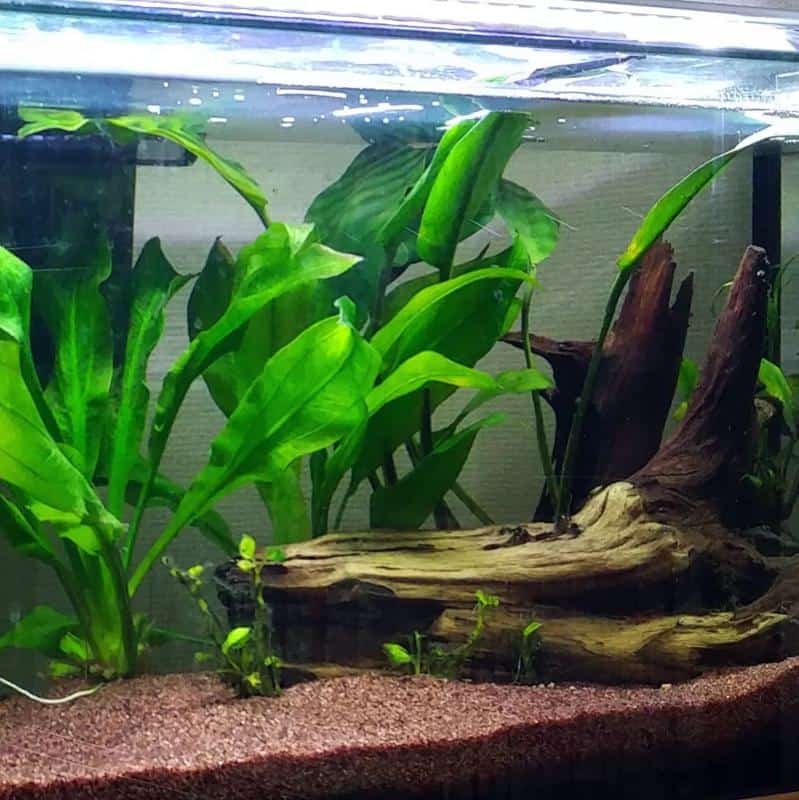
- Scientific name: Echinodorus grisebachii
- Type: Submerged
- Care level: Easy
- Growth rate: Slow
- CO2 Requirement: Recommended for faster growth
- Lighting: Moderate to high
The beginner-friendly Amazon Sword is hands down among the most popular plants in the aquarium hobby.
While the plant tolerates low-tech tanks, it flourishes under high lighting and warm water. CO2 injections aren’t required, but they will promote faster growth for these plants.
Under optimal conditions, Amazon Swords can grow up to 20 inches or more, and bear lovely white flowers. The pretty leaves can hold their own against goldfish.
Full-grown Amazon Swords provide fantastic coverage of the background of an aquascape.
2. Giant Vallis
- Scientific name: Vallisneria gigantea
- Type: Submerged
- Care level: Moderate
- Growth rate: Fast
- CO2 Requirement: Recommended
- Lighting: Moderate to high
Scientifically known as Vallisneria gigantea, it is a larger variant of the more popular grass-like plant Vallisneria nana.
The Giant Val anchors deep into the substrate. It does best on iron-rich substrates or quality aquarium soil. Giant Vals also have a large range of water hardness and temperature.
Living up to its name, it grows quite fast. Long, flattened ribbon-like leaves arise and spread along with side shoots.
In most aquariums, the leaves grow so long and create a jungle-like appearance. The leaves are robust; they are not normally eaten by the likes of goldfish.
Giant Vals take full sun or moderate to high lighting, which is good news since you are most likely to use bright lights in grooming fancy goldfish.
3. Anubias
- Scientific name: Anubias barteri, Anubias coffeefolia, and Anubias congensis
- Type: Emergent
- Care level: Easy
- Growth rate: Very slow
- CO2 Requirement: Recommended for faster growth
- Lighting: Low to moderate
Extremely hardy, Anubias are popular among beginners due to their ease of care and low-light requirements.
You don’t need to plant Anubias in the substrate, which makes it an excellent option for goldfish. Simply wedge them between decorations using glue or tie them to driftwood. The thread will deteriorate in the water, leaving you with a well-anchored plant.
You can even leave Anubias floating and they will grow just fine, as long as the roots and rhizomes stay exposed to the water column. Their root systems will absorb nutrients directly from the water.
Aim for large species like A. barteri, A. coffeefolia, and A. congensis as they are bigger and more resilient. These plants have tough, rubbery leaves that goldfish dislike.
The only downside to Anubias is that they are vulnerable to algae growth on the leaves and suffer in strong lighting. This can be a problem if you are grooming fancy goldfish since they need high-light conditions.
4. Java Fern
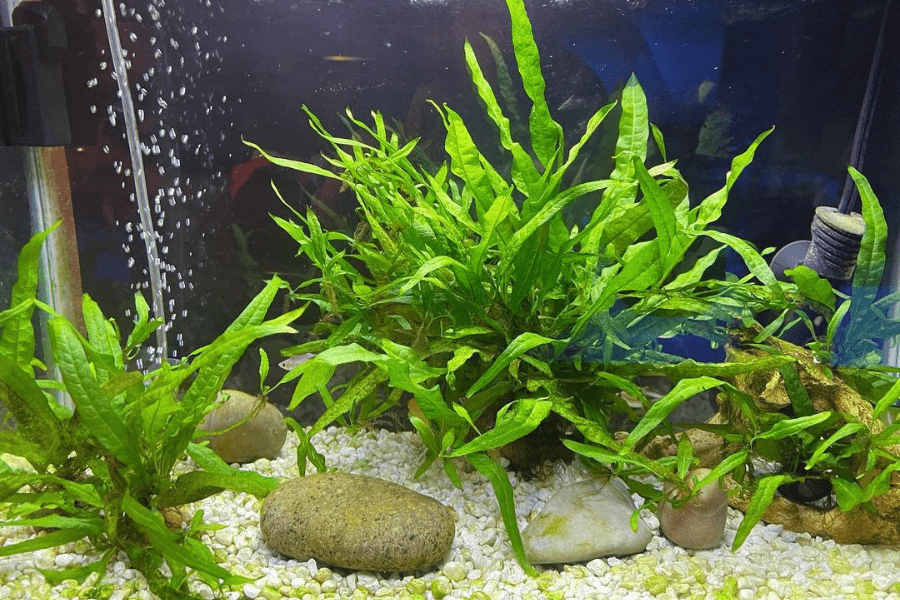
- Scientific name: Microsorum pteropus
- Type: Emergent
- Care level: Easy
- Growth rate: Slow
- CO2 Requirement: Recommended for faster growth
- Lighting: Low to moderate
Similar to Anubias, these plants make great plants for rookies. Java Ferns don’t require sizable investments in powerful lights or special substrates to grow.
While Java Ferns don’t come in a wide variety, the most popular ones include the Narrow Leaf, Needle Leaf, Trident, and Windelov.
Java Ferns will attach to virtually anything. Although they take forever to grow, the finished result is spectacular.
The lush vegetation will provide tons of hiding places of relaxation for other fish in a community setup.
5. African Fern
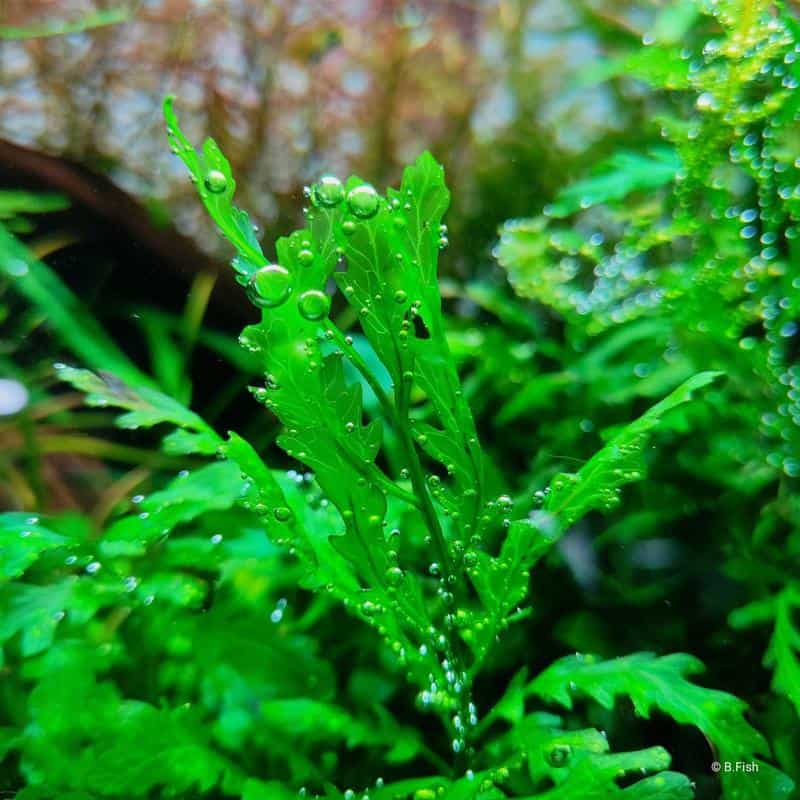
- Scientific name: Bolbitis Heudelotii
- Type: Emergent
- Care level: Easy
- Growth rate: Slow
- CO2 Requirement: Recommended for faster growth
- Lighting: Low to moderate
Also known as the Congo Fern, this species hails from the tropics of West Africa. African Ferns boast textured, emerald-green cascading leaves that look semi-translucent.
With proper care, the gorgeous African Fern can be a long-lasting addition to your tank. While it tolerates a range of water conditions, it is best to place it in an area experiencing higher flow rates.
The hardy plant will grow into an impressive bush if you offer medium lighting and liquid fertilizer. By then, regular trimming might be required to keep it from being too large.
6. African Onion Plant
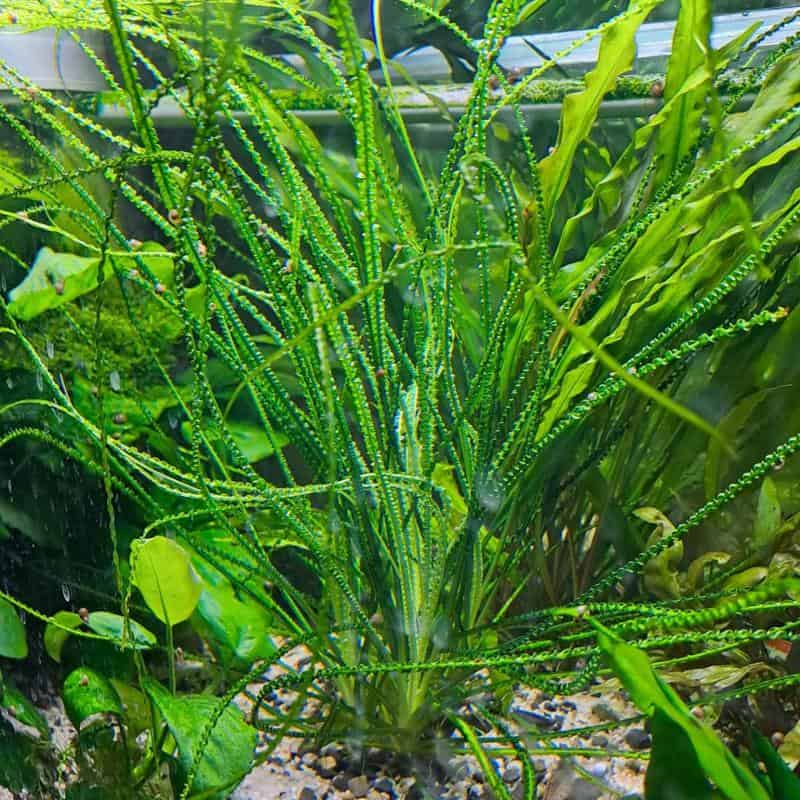
- Scientific name: Crinum Calamistratum
- Type: Submerged
- Care level: Easy
- Growth rate: Slow
- CO2 Requirement: Low
- Lighting: Low to moderate
The African Onion Plant got its nickname for its close resemblance to onions.
The leaves are long, spiral, spindle-like, and dark green. Wrinkled and curly, they look like tentacles that grow upwards.
At first, African Onion Plants may look unhealthy while adapting to water conditions. If you provide low to medium lighting and fertilizer, they will become well-established and produce ruffled tendrils that reach the surface of your aquarium. It can grow beautiful white flowers as well.
7. Moss Balls
- Scientific name: Aegagropila linnaei
- Type:
- Care level: Easy
- Growth rate: Very slow
- CO2 Requirement: Low
- Lighting: Low to moderate
Marimo Moss Balls are actually a type of algae that maintains its round shape by being bounced around at the bottom of lakes. Place these velvety orbs in your aquarium and let your goldfish push them around for fun.
Once in a while, swish these balls in a bucket of water to remove fish waste and other debris that might have gotten stuck on the fuzzy surface.
Marimos are easy to care for and prefer low light. Despite being slow growers, these algae balls will help keep your goldfish tank clean by removing nitrates from the water. They will also harbor beneficial bacteria.
Moss balls also prevent other less desirable algae from growing. This makes it ideal in tanks with other slow growers like Anubias and Java Ferns.
Cons of a Planted Tank
Be realistic about your expectations as you design your setup. Those amazing aquascapes you see on blogs and social media are impressive without a doubt, but without commitment, they are unlikely to last long against goldfish.
Consider tank maintenance. Planted aquariums need a lot more time and effort than bare-bottom tanks lacking live plants.
Maintaining the appearance of your live plants may also require pruning. Plastic plants don’t require nutrient supplementation, special substrates, or specific lighting, whereas live plants do.
That’s why you need to do your homework and make sure you can meet a plant’s specific needs.
Be prepared to adjust your expectations and be flexible. Don’t get discouraged if things don’t turn out as expected. You can learn from the experience and try again.
When Do You Add Plants?
It is a wise idea to get the plants in first if you are just starting out and have yet to set up your tank. This allows plants to establish roots without the risk of uprooting.
If your goldfish already occupy the tank, you will need extra measures to keep the plants in place. You can place smooth stones around the base of the freshly planted plants to weigh them down.
Does a Planted Goldfish Tank Need Light?
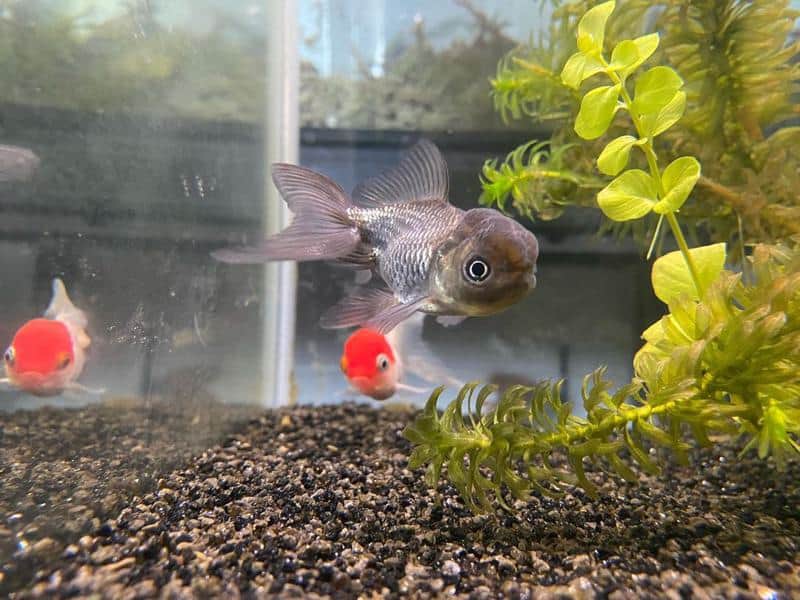
Yes. Light is the most influential factor when growing aquarium plants; otherwise, your plants will die.
Deciding how much light you need for your aquarium depends on several factors:
- the plants you want to grow
- how fast you want them to grow
- whether or not you’re injecting CO2, and
- how much time you are prepared to dedicate to maintaining your plants.
Aquarium plants require different amounts of light to survive. Lower light-demanding plants are generally easier to grow, making them the most suitable choice for beginners or for low-tech aquariums.
Plants like Anubias, Java Ferns, and African Ferns, don’t need intense and long exposure to light. The intensity of the light will drive the plants’ need for more CO2 and nutrients.
Otherwise, their leaves would curl and turn brown or yellow due to nutrient deficiency. Eventually, the leaves would rot.
This is because your plants grow quicker under higher lighting intensity, which increases CO2 and nutrient absorption. Too much light without fertilization and CO2 supplementation will result in poor plant growth and algae.
Consider introducing a floater to grow above and provide shade to your plants below. Additionally, invest in a UV sterilizer to prevent algae outbreaks.
Can I Keep Live Plants While Grooming Goldfish?
Maintaining a balance between your goldfish and plants will be extremely difficult.
Grooming fancy goldfish requires intense lighting to improve their coloration.
Therefore, you will need plants with high light demands.
Higher light often requires more maintenance too, as your plants will grow faster leading to increased pruning, fertilization, CO2 demands, and water changes.
Live vs. Fake Aquarium Plants: Which Is Better?
Fish experts agree that goldfish are unkind to live plants. Goldfish peck, push, and dig up plants, which is a shame as live plants are beautiful and beneficial to your aquarium.
That’s why some hobbyists resort to artificial plants for the following reasons:
- Fake plants are durable. Goldfish may peck on them to try to find food but never destroy them.
- Plastic plants last. They retain their shape and color. Your goldfish can rearrange the decor however they like.
- Artificial plants are low maintenance, which makes them suitable for busy or novice fish enthusiasts. They require no upkeep, except occasional scrubs to remove algae.
- There are many choices, ranging from lifelike to whimsical glow-in-the-dark neons. There will always be something to suit everyone’s taste.
While some plastic plants look realistic, they can never achieve the beauty and level of realism of live plants.
Also, care must be taken when selecting fake plants because some have sharp edges. This can be a problem for fancy goldfish with long, flowing tails. It is advisable to stick to silk plants where possible.
Having tried both, I definitely believe real plants make for a healthier and more attractive goldfish aquarium than fake ones. If you like, you can mix artificial plants with live ones.
Also Read:
Wrapping Up
To create a successful planted tank for goldfish, you’ll need to choose hardy plants that can withstand the playfulness and foraging behavior of goldfish. For rooted plants, make sure to choose a substrate that allows plant growth.
If you are just starting out, it is easier to choose low-light plants. Lower lighting means less CO2 and less fertilization. There is also a reduced risk of algae outbreaks.
Adding plastic plants is another convenient and simple way to spruce up your fish tank. These things don’t even need water, let alone lighting and fertilizer!
However, artificial plants will never be as beautiful as live plants. Nature’s beauty can’t be mass-produced!
